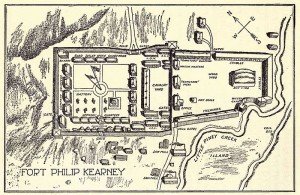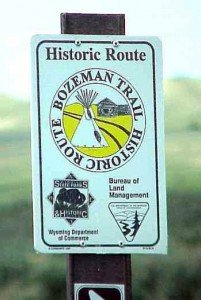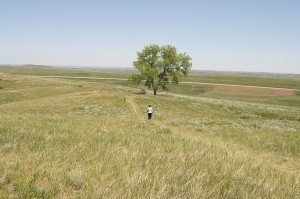The Frontier Cavalry
One of the most significant battles of the U.S. frontier army in the 1860’s was the Fetterman Fight which is often referred to as the Fetterman Massacre. This battle among the U.S. Cavalry and Sioux Indians occurred in Wyoming a decade before the Battle of the Little Bighorn. There’s been a tremendous amount written about Custer’s Last Stand at the Little Bighorn. Much less has been written about a conflict which happened in Wyoming, about 25 miles south of the present day city of Sheridan.

The Bozeman Trail
Back in the mid to latter part of the 1800’s many areas of the western U.S. where immigrant traffic was significant. One place in particular was the area of northern Wyoming. During the 1860’s, army forts were built along an emigrant path called the Bozeman Trail. This trail was a cutoff from the heavily traveled east/west Platte Road and Oregon Trail which was the main overland trail used by people moving to the west from the area of western Missouri. The Bozeman Trail ran northwest from the Platte Road beginning near Fort Laramie, WY. This trail ran to Montana where gold mining at that time was booming. Fort Laramie as well as Fort Phil Kearny and Fort C.S. Smith to the north were built along the Bozeman Trail to help protect wagon trains from Indian attack. Much of the trails traffic at that time were from miners heading to the gold fields. There are many side stories that go along with the history of this area but one, the Fetterman Fight, in particular, is of historical interest.
The Settlers and Miners Flood the Area
Fort Phil Kearny which was directly on the Bozeman Trail north of Fort Laramie was under constant assault from several Indian tribes, most notably the Lakota Sioux. The issue from the Native American perspective was simply that they had occupied this land for centuries and were understandably not happy to give it up. The massive flow of settlers were a steady reminder to them that things were changing fast. The gold boom in Montana worsened the situation from the perspective of the Indians. In addition, the emigration from the east disturbed the buffalo hunting grounds which were the main source of sustenance for the plains tribes. In a situation like this conflict is inevitable.

The Fetterman Massacre
There were many skirmishes between the U.S.cavalry and Indian during this period and many books have been published on the topic.Many moves as well have been produced on the subject of the Indian Wars. Regarding the area of Wyoming and Montana there was one conflict in the 1860’s which stood out among all others.This was called the Fetterman Massacre. In essence, an entire command of cavalry and infantry soldiers (81 in all) commanded by a Captain William J. Fetterman stationed at Fort Phil Kearny were annihilated by a surprise grouping of some 1500-2000 or more Indians on Dec 21st, 1866. The battle itself lasted only about thirty minutes. There are many reasons why this occurred and who may or may not have been to blame. Most accounts appear to place the blame on an overly eager cavalry officer who reportedly disobeyed direct orders from the fort commander, Colonel Henry B. Carrington.
Test your knowledge with our short twenty-five question history quiz
On the same day of this massacre, the Indians had attacked another site just outside Fort Phil Kearny and Captain Fetterman was sent out with his troops to give chase. A small group of Indians made themselves known to the soldiers not far from the fort and near a rise in the terrain. Captain Fetterman, in pursuit, led his troops over this small rise. This was only about one mile from the fort itself.

Unknown to Fetterman was the fact that the Indians had hid in gulleys and behind rocks just over the crest ready to spring the trap. After ascending the rise, the troopers were greatly overwhelmed by the attacking Indians. The rise was in eyesight of the fort but not the battle site just over the rise.
The Aftermath and Conclusions
The Fetterman Fight in 1866 stood as the U.S. Cavalry’s worst defeat up to that date. George Armstrong Custer’s battle was still 10 years into the future. That historic battle would take the place of the Fetterman Massacre as the worst cavalry defeat during the Indian Wars.

The obvious fact that the troops in this instance were vastly outnumbered certainly contributed to the defeat. In addition, the soldiers were using outdated weaponry such as the single shot muzzle loading Springfield Civil War era rifle. This was before the use of repeating rifles which changed the odds greatly. A contributing factor was that the soldiers in this battle were not considered experienced Indian fighters and did not display the horsemanship of the average Indian warrior. Although taking place very near the fort, the battle field could not be seen from Fort Phil Kearney and this delayed the sending of reinforcements in any timely manner.
Also, you’ll enjoy our photo article regarding the Battle of Palo Duro Canyon Texas during the Red River War.
Much was made of the fact that Captain Fetterman went against the orders of his commander, Colonel Carrington. The question of why Fetterman led his troops over the rise will never be answered for certain.
As a side note, there are many stories connected with this particular battle, the fort itself, the commanding officer of Fort Phil Kearny, a Congressional inquiry and the army’s response. A decade later the Battle of the Little Bighorn was actually a continuance of the unrest in the Wyoming/Montana region. There are some very interesting books available on the subject and you’ll probably find information at your local library that cover these topics from both the governments perspective and that of the Indian. Only the Battle of the Little Bighorn stands as a larger defeat for the frontier U.S. Cavalry.

What the visitor to this site in Wyoming will see is a monument dedicated in 1908 at the very sight of the battle (the top of Lodgepole Ridge). Fort Phil Kearny itself was burned down by the Indians shortly after the army vacated the fort some two years later supposedly because the expanding railroad was making the trail obsolete and as part of an agreement to end Red Cloud’s War of which the Fetterman Massacre was a part. Red Cloud’s War, led by Chief Red Cloud, is often referred to as the one Indian War lost by the U.S.
Visiting the Site
There is a monument (shown above) at the site of the battle which is accessible to visitors. As mentioned above, the monument was erected during a ceremony on July 3, 1908. The site is in Johnson County Wyoming, about 25 miles south of Sheridan Wyoming and just west of Interstate-90. For the history minded traveler, this site would be a great addition to a western U.S. trip planner.
(Photos and images from the public domain)
